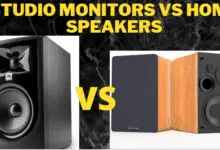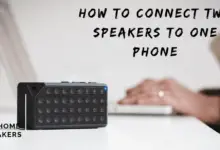Are you the proud owner of a brand new home theater receiver and surround sound speaker system? Want to save money by doing your own installation? Here are some tips to get you going.
For a basic installation, you won’t need a lot of tools. This guide explains in clear simple steps on how to Connect Home Speakers To Receivers.
A wire cutter/stripper is essential. A flashlight may come in handy. And you may need a laptop or tablet to read the instructions or watch the how-to videos you’ll find below.
Many receivers don’t come with printed manuals, just links to online documents. But most receivers do come with a short quick-start guide that covers the essential steps to get you up and running.
We have a guide on How To Connect Floor Standing Speakers To Receivers, Can Home Theater Speakers Be Used In A Computer, All You Need To Know About AV Receivers, and also How to connect multiple Bluetooth speakers to Mac and Windows Pc. You will want to check them out.
Before you roll up your sleeves to get started, read the quick-start guide and the tips below. Then make a plan and a shopping list. Your project will go a lot smoother if you have all the parts you need on hand before you begin.
Table of Contents
How To Connect Home Speakers To Receivers
Label your cables and speaker wires
Do you have Crutchfield CableLabels™ or an alternative label-making plan? Labels make it easy to keep track of what goes where. Some day you may want to move or replace your receiver. That’s the day you’ll thank yourself for labeling the cables now.
Where will the receiver go?
Pick a spot that’s well ventilated. Make sure you’ll have easy access to the connections on the back of the receiver.
Do you want your receiver to be heard, but not seen? You’ll learn about installer-friendly entertainment furniture that hides your gear behind closed doors. You’ll also find some ideas about how to conceal your gear in a closet or utility room.
Where will the speakers go?

How much speaker wire will you need?
Once you know where your speakers and your receiver are going, you can figure out how much speaker wire you’ll need. Use your tape measure to get a rough idea.
Or use a long piece of string to simulate each wire run, then measure the strings. See some tips in the video below.
Want to hide the rear speaker wires?
What’s the best way to run wires to the rear speakers? You have three main options, two of which are no sweat for DIY installers.
- Buy flat wire for under-the-carpet runs.
- Use raceways (also known as cable tunnels) to hide wires without cutting into your walls.
- Conceal wires behind your walls or baseboards.
- Use flat speaker wire when you want to conceal it behind your baseboard or under your carpeting.
Speaker connections
Prepping the speaker wires can be a tedious job, but take your time and do it right. You need secure connections that will stay put for years.
Why do you need speaker wire connectors?
Connecting bare speaker wires to a receiver is a real pain. You’ll be making at least 10 connections in a crowded pack of input jacks. A single stray wire strand could cause a short circuit that shuts down your receiver.
Do yourself a favor and get a bunch of banana speakers (four per speaker wire). A 20 pack will dress both ends of each speaker wire in a 5.1 speaker system.
How to put the connectors on your speaker wires
- Split the wire down the center
- Trim insulation from the wire ends
- Attach the connectors, as shown in the video below.
Make sure you match the colors on the connectors (usually black and red) to the colors or markings on each side of your speaker wire. It’s important to be consistent so you maintain the proper polarity. For more tips, watch the video below.
How to connect your speaker wires to the receiver
Make your speaker connections before you plug in your receiver’s AC power cord. If you need to re-do any of the connections, first turn off and unplug the receiver.

As you plug the speakers in, match the colors on the connectors to the colors on the speaker input terminals.
Power connections
Protect your investment. Don’t plug your gear directly into AC power outlets or cheap power strips. A high-quality power protection device will keep your gear from being fried in the event of an electrical surge.
A good power protection unit will give you all the outlets you need, and it will filter noise out of your AC power supply. You’ll get surge protection and better performance from your gear.
TV and component connections
Do you have all the AV cables you’ll need? Are you sure they’re the right length?
Don’t have easy access to the back of your cabinet? You’ll need to attach the cables before you slide the components into the cabinet. That means you’ll need longer cables to give yourself a few extra feet of slack.
Frequently used cables you may need
- HDMI, for your cable or satellite box and for AV components like Blu-ray players and game consoles. To make sure you have the right kind of HDMI cables for 4K components, read our article on HDCP 2.2 copy protection.
- RCA for analog audio connections
- Optical or coaxial cables for digital audio connections
Connect your TV first
Many of today’s receivers have onscreen guides that walk you through the setup process. That’s why Step 1 is to connect the TV. Use HDMI output 1 or “Main” on the receiver and HDMI input 1 on the TV.
Are you using your TV’s built-in video streaming apps or an antenna for over-the-air TV? Use the HDMI connections marked ARC (Audio Return Channel).
If you have an older TV or receiver that lacks ARC, connect an optical digital audio cable between your TV and receiver. Of course, you’ll still need the HDMI connection for the video signal.
How to connect your powered subwoofer
This is pretty simple. Run a subwoofer cable from the subwoofer output on the receiver to the subwoofer’s LFE input. If you prefer a wireless connection, you can get a wireless connection kit.
Setup and finishing touches
After everything’s connected, it’s time to fine-tune your system and set it up to work the way you want. This is where it helps to read the manual.
The full manual may run well over 100 pages, but it’s worth reading at some point. At least skim through it once. You may be surprised to find some features and settings that enhance your enjoyment or spark some ideas for system expansion.
Speaker calibration
Most receivers come with auto-calibration to fine-tune the sound. Here’s how it works:
The receiver sends test tones to a microphone placed at your seating location. Then the receiver automatically adjusts the volume and timing of the sound coming from each speaker. You get perfectly balanced and time-aligned surround sound. See how it works in the video below.
Network setup
Follow the network setup instructions specific to your receiver model. In most cases, it’s no more difficult than connecting your phone or laptop computer. If your receiver and Wi-Fi router support WPS (Wi-Fi Protected Setup), all you have to do is push a couple of buttons.
Can you listen to the TV speakers when the receiver is turned off?
At times, you or your guests may just want to watch TV and not bother with the surround sound. You can do that if your receiver has a feature called HDMI standby pass-through.
The signal from the cable box (or another source) goes through to the TV when the receiver is turned off.
If your receiver doesn’t have an HDMI pass-through, you can get an HDMI splitter and run a second cable to another HDMI input on your TV.
The downside is that you’ll have to switch the input selection on your TV each time you want to go from surround sound to TV speakers or vice versa.
Conclusion
So there you go, all you need to know about How To Connect Home Speakers To Receivers.





